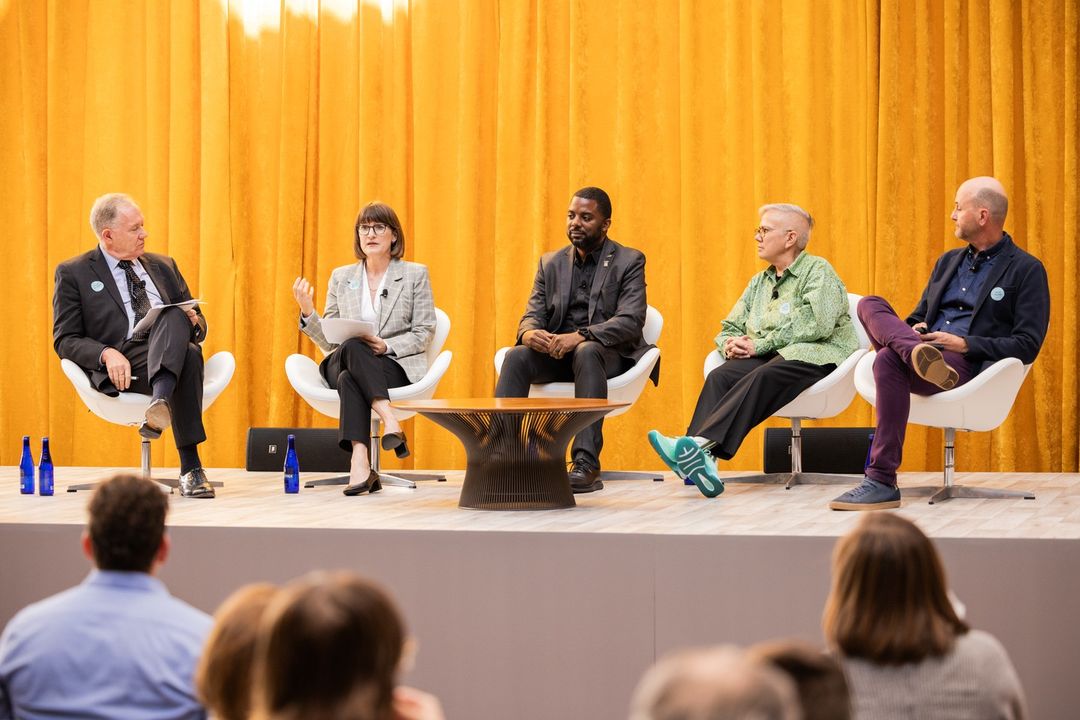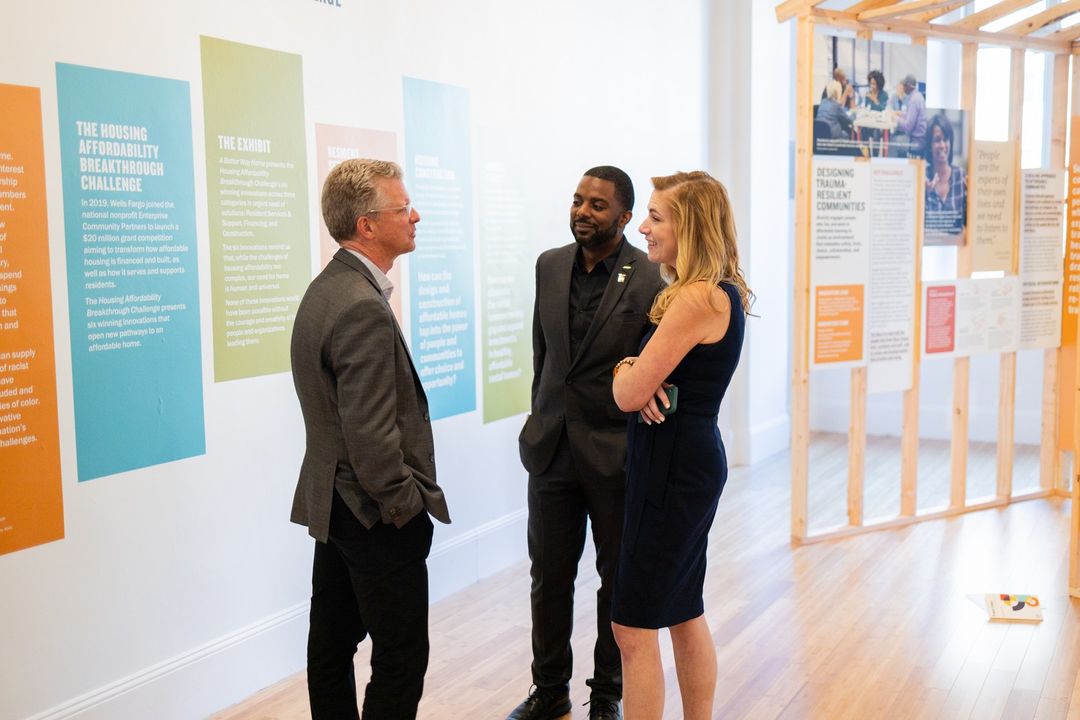Future Cities Initiatives
The Museum launched Future Cities in 2023 with a public symposium asking what communities and neighborhoods lose when housing is unaffordable. Building off the day’s momentum, in partnership with AARP, we are scaling Future Cities into a three-year investigation of the changing nature of the urban environment as it evolves to meet the challenges of urban growth and aging demographics. The wellbeing and prosperity of urban residents relies not only on the functionality and health of the city, but on the vibrant life of the urban core, unique in its identity, diversity, and culture. Globally, rapid urbanization is at the nucleus of multiple crises including growing inequality, climate change, housing shortages, biodiversity loss, and food and water security. How do our cities evolve to remain and become beacons of space that are livable, desirable and vibrant?
As cities tackle these critical challenges, the future city reimagines a more equitable, sustainable, and livable future for all urban residents. How will innovations in transportation, technology, policy, and civic engagement inform and change cities? What does the future city look like, and how does it provide greater access and agency for its urban residents? The National Building Museum will investigate how communities, industry, and government can and will work together to shape the greatest reimagining of the American landscape since World War II.
Housing Affordability Summit
On September 19, 2023, the National Building Museum hosted the Future Cities: Housing Affordability Summit, a day-long convening around the topic of affordable housing. One overarching question guided the day: What do communities and neighborhoods lose when housing is unaffordable? Recognizing that neither policy, design, nor advocacy alone can meaningfully address the underlying inequity of housing in America, a diverse group of 22 thought leaders from these fields engaged in critical conversations about the challenges and opportunities facing communities around this timely issue. They were joined by 257 attendees.
The Museum hosted the Summit in association with A Better Way Home: The Housing Affordability Breakthrough Challenge, which opened in October 2022. This exhibition tells the story of the six winners of the $20 million grant competition sponsored by Wells Fargo and Enterprise Community Partners to transform how affordable housing is built, financed, and serves and supports residents. This exhibition is on display through January 2024.
The Summit opened with a powerful keynote address by April De Simone. Questioning the inequitable value attached to homes based on neighborhood desirability, De Simone asked how society can heal historic harms instead of reinforcing the same inequitable systems. She argued that “Housing is the vein of American democracy,” and by centering home and equitable access, we can allow people to have choices in desirability of home and community. She referred to wide-reaching historic examples of policies such as the New Deal.
Moderated by Shane Philips, author of “The Affordable City,” the keynote panel spoke to affordable housing as one piece of an equitable and thriving city in a holistic approach. The panel discussed the trade-offs involved in creating affordable housing at scale, and questioned whether the racial wealth gap and housing can be solved together, or if housing as shelter needs to be separated from real estate as a wealth building tool. Every policy and solution has trade-offs, thus trying to solve the housing affordability crisis with only housing reforms will fail. The discussion focused on the critical need for a holistic approach to housing reform, that considers liveability and opportunity, requiring a myriad of policy solutions including housing affordability, with consideration of income inequality, access to transportation, jobs, education.
Session One addressed affordable housing and the equitable energy transition, discussing the tools needed to connect vulnerable communities to funding and resources. The panel spoke about the combined approach of resilience and decarbonization, and how to deliver benefits to communities without unintended consequences such as increased household expenses or displacement. The main takeaway was that climate change is not the number one priority for many residents, especially those who do not have expendable income to make proactive improvements, so solutions need to address how to make resilient changes economical for those in affordable housing and increase education to expose residents to these resources. The panel also discussed the critical need for zoning reform beyond the single-family home, as well as the role of insurance policies in identifying and evaluating resilience measures.
Teddy Cruz and Fonna Forman opened their talk with an image of the demolition of the Pruitt-Igoe housing complex, which signaled the shift in affordable housing from the realm of the public to that of the private sector. They argued that new paradigms in affordable and inclusive housing design demand structural transformations in housing policy, and a new political economy to support alternative social densities, transitional uses, and shared economies. Cruz and Forman shared projects that create housing as public infrastructure, transforming autonomous “units” into relational social systems that spatialize urban justice. The main takeaway is that affordable housing needs to be embedded in social, cultural, and economic systems. When it is, affordable housing takes on a different meaning and can be robust with social interaction and democratization.
In Session Two, the panelists discussed how housing development alone cannot solve the problem of affordability. Practitioners, developers, and governmental agencies shared their insights on tackling the problem of affordable housing from many angles including zoning, community benefits agreements, building wealth, and preserving existing stock. The key takeaway was that there needs to be more support for innovative solutions because there is a not a one-size-fits all approach to housing, and any solution needs to be grounded in that specific community to make sure all stakeholders are represented and heard.
The low- and middle-income aging population is most affected by lack of affordable housing. Even though everybody gets old, we often think of aging as someone else’s problem. This panel investigated the burdens posed by the shortage of affordable housing for older adults, and the advantages for the entire community of offering more options including nontraditional housing that serves multiple generations. Panelists discussed the various barriers to realizing this vision, including zoning, NIMBYism and budget constraints, while also sharing strategies for overcoming these barriers to fill the “missing middle” gap in housing. The takeaway was that there is a need for more options in different housing types that respond to demographic changes, and zoning that allows for different options beyond the single-family home that respond to resident needs.
Shaun Donovan ended the Summit reiterating the importance of affordable homes, as they raise economic impacts and growth, decrease divisions and advance racial equity and justice. He reminded the audience that it is a historic moment in affordable housing and urged everyone to utilize their resources to move forward with the ideas, solutions, and relationships that had been introduced and nurtured during the day.
Interactives
In addition to the speakers, several pop-up interactives and books were featured in the venue to further the overall understanding of the breadth and depth of affordable housing. Pop-up exhibitions included: Democracy Is…., an immersive pop-up exhibition by The Practice of Democracy, exploring the relationship between the promises of democracy and lived experiences through a past to present timeline; Before the Bulldozers: Historic Southwest D.C. Exposed, an audio and augmented reality pop-up exhibition by the Smithsonian Anacostia Community Museum, telling the story of the country’s first large-scale urban renewal project that uprooted an entire community of people to create new neighborhood; and The Future of Housing in an Aging Amercia, an interactive pop-up by AARP, showcasing the AARP Livability Index™ platform , a web-based tool that scores neighborhoods and communities across the U.S. through services and amenities. Books on the topic were also displayed and available for purchase at the Museum, ranging from The Affordable City: Strategies for Putting Housing Within Reach (and Keeping it There) by Shane Philips, to Missing Middle Housing: Thinking Big and Building Small to Respond to Today’s Housing Crisis by Dan Parolek, to Socializing Architecture: Top-Down / Bottom-Up, by Teddy Cruz and Fonna Forman. Finally, the Museum’s exhibition A Better Way Home was also open, and many attendees toured it throughout the day.
Impacts
In total, 257 people attended the Summit representing a wide range of demographics and professions. Of the total attendees, 44% identified as white and 40% as persons of color. Participants were evenly split across age ranges and we were pleased that 15% were students. The majority of attendees came from the Washington, D.C., Maryland, and Virginia region, yet almost 10% visited from outside the local area. A variety of professions were represented including architecture and design, housing sector, urban planners, academics, historic preservationists, developers, and policy advocates. We were thrilled to offer CEUs through the American Institute of Architects, with 24 participants taking advantage of this offering. The Summit enabled the Museum to reach a wider audience with partners sharing information on the Summit through their social media channels, including DC Office of Planning, Harvard Joint Center for Housing Studies, Washington Housing Conservancy, and Smart Growth America.

Looking Ahead
Housing has always been central to the Museum’s work. The exhibition Affordable Housing: Designing an American Asset opened in 2004, and Evicted, which was at the Museum in 2018-2019, ended its national tour this year. In 2011, the How Housing Matters conference, a one-day convening, presented in partnership with the MacArthur Foundation, HUD and PD&R began a multi-year partnership between these organizations to explore affordable housing. The work included a second symposium in 2014 and the opening of House & Home, which remains one of our signature exhibitions.

With this strong history, the Museum is committed to continuing to engage audiences around this important topic. In December of 2023, in partnership with AARP, the Museum announced plans for a multi-year Future Cities initiative that will explore the future of the country’s urban spaces and how we can increase the livability of our neighborhoods and communities to make them vibrant and welcoming places for people of all ages. Read more about the partnership here and watch the video below to learn more about the AARP Livability Index™platform.
Sponsors
Thank you to the sponsors of the Housing Affordability Summit: AARP, Allstate, Enterprise Community Partners, Wells Fargo, The American Institute of Architects, American Society of Landscape Architects, Arup, MiTek, NCARB, STUDIOS Architecture, Bonstra | Haresign ARCHITECTS, and Moody Nolan.
